Wildlife gardening - Mammals
Making the garden friendly for mammals
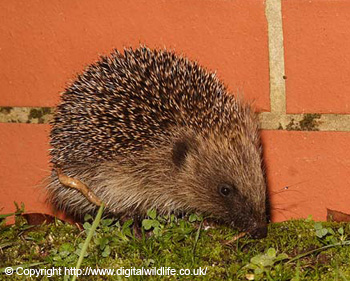
Whether you live in a rural village or a town, there will always be mammals that visit your garden. Many of them, like hedgehogs, only come out at night so they are not often seen, but others can be seen in the day time. In some towns urban foxes are a fairly common sight and can even be seen basking on lawns.
If you think you have small mammals visiting your garden, but haven't seen any yet, you can find out what they are by checking for footprints. To encourage mammals in your wildlife garden, put out some food - peanuts or a bit of tinned dog food - and put a thick layer of sand by it so that which ever animal eats it leaves their footprints behind. You can get guides on animal tracks that will help you to identify who your visitor is.
Hedgehogs
Hedgehogs live all over the UK and although they are quite common they are not seen very often because they are mainly active at night (nocturnal). They are solitary animals and don't defend a territory.
By encouraging them into your garden you have a good garden helper, as they will eat many pests, thereby saving you the trouble of dealing with many of them yourself.
Breeding
Hedgehogs breed once or twice a year, producing litters of about five hoglings. The babies will stay in the nest for five weeks, until they are weaned.
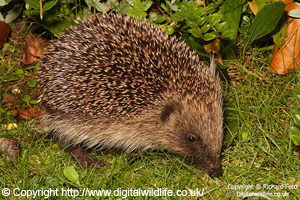
Hedgehogs are usually seen at night
What they eat
Their favourite foods are beetles, caterpillars, earthworms, slugs and snails but they will also eat fallen fruit, cereals, fresh meat and pet food. A source of fresh water is very important, especially in hot weather.
If hedgehogs are visiting your garden, you may hear them rustling and snuffling through the garden borders, and sometimes knocking over plant pots, in their search for food. If the garden is lit by street lights you can sometimes see them trotting about amongst the plants and over the lawn. Hedgehogs are noisy eaters and you may hear them grunting and chewing up worms and beetles before you see them.
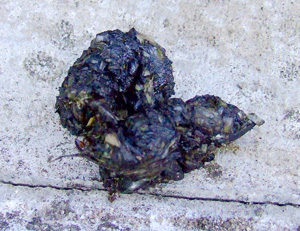
Hedgehog droppings
Hedgehog droppings
If you havenít seen the hedgehog itself, you can often tell one has visited because it will leave droppings here and there as it explores the garden. Hedgehog droppings are black and shiny, cylindrical and about 4cm long. You might see parts of insects in them, especially wing cases.
Getting in and out of the garden
You can encourage hedgehogs into your garden by ensuring that they can get in and out. Dig gaps under the fences between you and your neighbours and the hedgehogs will find them and crawl through.
Ways to help hedgehogs
There are several other ways that you can make your garden more hedgehog-friendly. Here are some things you can do.
Compost heaps
Hedgehogs like to make nests in piles of fallen leaves and at the bottom of compost heaps, so be extra careful when youíre gathering autumn leaves or turning the compost heap because there may be a hedgehog in there, or even a whole family. It would be easy, and very sad, to injure or kill more than one hedgehog with just one thrust of a garden fork.
Strimmers and lawn mowers
If someone is using a strimmer or lawn mower to cut long grass or undergrowth, check first to make sure there isn't a hedgehog hiding in there. Hedgehogs can be very badly injured or killed by strimmers and lawn mowers.
Dogs
Dogs may try to chase and kill hedgehogs so if you let your dog out in to the garden last thing at night, turn an outside light on for a few minutes before going outside to warn the hedgehog and give it time to move to safety. That, or put the dog on a lead for the first few minutes.
Ponds
If you have a pond, make sure that one side is sloping so that if a hedgehog falls in, it can climb out again. While hedgehogs can swim for short distances, if there is no way for them to get out of a pond they will drown.
Log piles and hibernation
Make a lose pile of logs, with some gaps so they can get in, and cover it with fallen leaves. Hedgehogs may use it for hibernation or nesting.
Hedgehogs will also nest or hibernate in piles of wood, including the piles being readied for burning. If youíre planning a bonfire, make the pile in a different spot to the one youíre going to burn in, and add the burnables to it so that any hedgehogs in there donít get incinerated.
Hedgehogs may wake up from hibernation during warm winter spells and theyíll need something to eat if they are to survive till spring. If you know that you have a hedgehog visiting, nesting or hibernating in your garden put some food and fresh water out during the warmer spells in winter. Tinned dog food is acceptable, but donít put out milk as this can upset their stomachs.
Fresh water
If you don't have a pond, always put down a dish of fresh water - a 5-7cm plant pot saucer would be fine. Do this all year round and hedgehogs will know it is there and come to drink from it.
The Red Fox
The red fox is a wild dog and although they aren't seen very often, they are common in the UK. It is easily recognisable, being the size of a small dog with thick ginger-red fur and a long, very bushy tail with a white tip. Foxes are usually solitary but occasionally form groups for a short time.
Breeding
Foxes breed once a year, producing a litter of up to seven cubs. The size of the litter depends on the amount of food available.
What they eat
Foxes will eat pretty much anything that can be eaten and their diet includes insects, worms, fruit, birds, small mammals and scraps left by humans, such as the roast bones people put out for birds and litter like sandwiches and burgers.
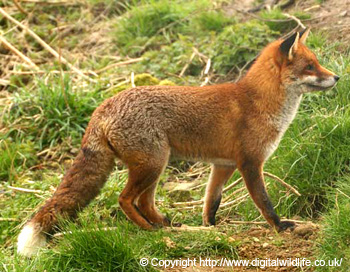
A very handsome-looking red fox
If you want to feed foxes, do consider your neighbours, who may not appreciate their presence. If more food is put out than a fox can eat in one go, it may bury it in your or your neighbour's garden. Putting out food in small pieces - things like raisins or peanuts - will mean that the fox spends longer in your garden picking all the bits up, and this should cause less risk of annoying your neighbours. Something to remember is that foxes are intelligent animals who actually cope very well without us feeding them.
Seeing them
Although they are generally shy animals, foxes can sometimes be seen in summer, lounging comfortably on urban lawns and surrounded by playing cubs. They can also been seen in the garden searching for food, sometimes digging for worms or knocking bins over to get at the contents.
More often, you'll discover that a fox has visited your garden because of its droppings, which are left to mark the territory. If you have a dog, make sure you dispose of any fox droppings you find, otherwise the dog will probably roll in them and you'll have the unhappy job of trying to wash it off. Even with the best dog shampoo, it will take a week to get rid of the smell! Another way of discovering that you have visiting foxes is finding whole eggs buried in the lawn or in a plant pot. Foxes are very dexterous and can handle, bury and dig up eggs without breaking them.
Many foxes live in the grounds of schools. These are ideal habitats - there are dry spaces under portacabin classrooms, plenty of discarded food and - outside school hours - space, peace and quiet. The gaps under garden sheds are also popular for foxes to make nests in.
There are very mixed feelings about foxes. Some people consider them a huge nuisance while others welcome them and put out food for them.
There are larger versions of the fox cub and the adult fox, which are worth looking at.
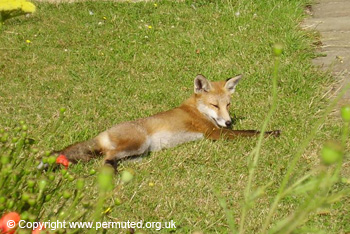
A fox cub basking in the sun on a lawn
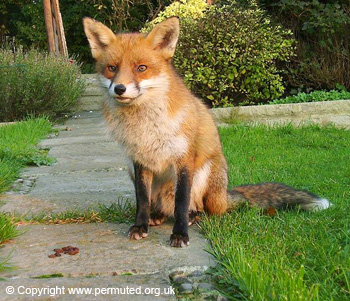
An adult fox about to eat some raisins
If you do want foxes in your garden
Because of our urban sprawl, there are fewer places for foxes to live in the rural wild and, as in prehistoric times, they have naturally moved closer to humans. Foxes are intelligent opportunists and if they see a good living in a town, that's where they'll live.
If you like foxes and want to see them in your garden, you can put out dishes of water, small bowls of tinned dog food, raisins and the dog treats called markies. Whole hen's eggs are also very popular. You may need to be patient, but if there are foxes in your area, then soon enough they will find the food and will add your garden to their round.
Foxes are wild animals and usually very nervous of humans, so it is better that you don't try to approach them, but watch them from a distance. Like all wild animals, if they are scared and feel threatened they can bite, and while there isn't a problem with rabies in this country, foxes have a lot of very sharp teeth.
If you don't want foxes in your garden
They are both handsome and fascinating, but foxes can cause annoyance by leaving droppings, damaging gardens and by screaming very loudly at night (which sounds rather human and can be very alarming if you don't know what it is). If you don't want foxes in your garden, there are various humane powders and sprays available from garden centres that can be put down to deter them - to a fox, this is the same as marking a territory; if it thinks the territory is taken, it will go somewhere else. It is illegal to use poisons or inhumane methods of control.
Other small mammals
Wood mice, field mice and voles might also be living in your garden. You can watch them close up by making a feeding table for them. This could be a wooden shelf attached to a downstairs outside window sill. Make sure that the mammals can get to it by placing a shrub or climber nearby that they can climb up. Put some seeds and chopped nuts on the shelf and then wait quietly at dusk for them to arrive. Birds will probably visit the feeding shelf too.
Once a week, remove any uneaten food from the shelf, and the ground beneath, and give it all a good scrub. This will help to stop diseases from spreading and help to keep your visitors healthy.
A note of caution
Many small mammals like to hibernate at the bottom of wood piles. If you are planning a fire for Bonfire Night, make sure you check right to the bottom of the heap before lighting it to save them from being trapped by the flames. Better still, store the wood in a different spot to where it will be burned. More here: Garden Journal November 5th 2007

© Copyright Miranda Hodgson 2007
Many thanks to Richard Ford at Digital Wildlife for the use of the hedgehog and the standing fox photos. Many thanks also to Paul at Everything is Permuted for the use of the cub and sitting fox photos.